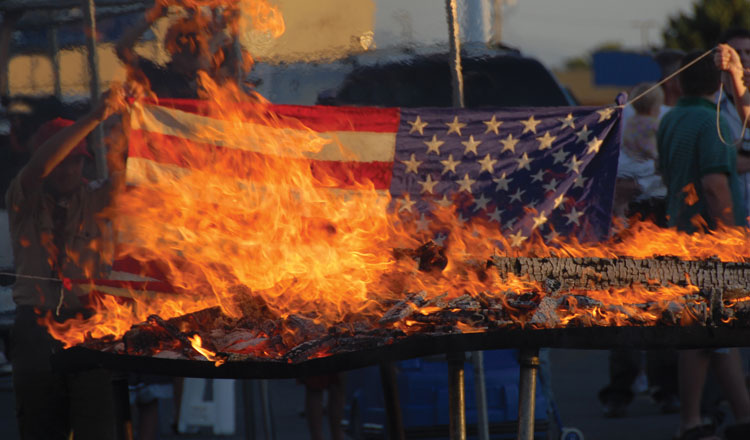Aug. 22, 1984: Flag Burning Tests the Law

Photograph by Gordon Galbrath/Shutterstock.com
It was a searing August afternoon that found communists and anarchists afoot in downtown Dallas. While attendees of the 1984 Republican National Convention took refuge from the heat on Aug. 22, 1984, protesters had taken to the steamy, nearly deserted streets. Television cameras, hungry for dissonant voices, focused on a keenly theatrical group that called itself the “Republican War Chest Tour.”
Although the Vietnam War was well in rear view, the invasion of Grenada and simmering conflicts in Latin America kept the nation’s foreign involvements at issue, and the protesters were doing their level best to focus that narrative on global divisions between rich and poor.
The group scrawled anarchist glyphs on storefront windows, bellowed anti-imperialist slogans while marching through Neiman Marcus, and tumbled to the ground on cue to dramatize the deaths of innocents at the hands of the machinery of war.
Outside the Mercantile Bank Building, several protesters pulled down one of 16 American flags regularly on display. As police watched, they handed it off to one of their number, Gregory Lee Johnson, who stuffed it under his shirt.

Photo of Gregory Lee Johnson by Joel Seidenstein/Wikimedia Commons/CC BY-SA 3.0
As the march reached city hall, Johnson unfurled the flag and, holding it in one hand, flicked open a lighter with the other. When the flag failed to catch fire, lighter fluid was dispensed to hasten the ignition. As the flag dropped to the sidewalk in ashes, the protesters chanted and the police moved in.
As many as 100 protesters were taken into custody for disturbing the peace, but only one was charged. Johnson, a self-described communist revolutionary from Atlanta, was cited under Article 42.09(a)(3) of the Texas Penal Code, which prohibited “desecration of a venerated object,” defined specifically as a public monument, a place of worship or burial, or any state or national flag.
At trial, a Dallas jury found Johnson guilty of a misdemeanor, and he was sentenced to a year in jail and a $2,000 fine. The conviction, however, was vacated by the Texas Court of Criminal Appeals on grounds that the vagueness of the Texas law had not protected Johnson’s constitutional right of free speech.
Since World War II, the Supreme Court had grappled repeatedly with tensions between free speech and patriotism, often involving veneration of the national flag. By the time Texas v. Johnson reached oral arguments in March 1989, Texas authorities had conceded that Johnson’s flag burning was an act of protected speech.
But arguing for the state, Dallas County Assistant District Attorney Kathi Alyce Drew maintained that Texas had a vital interest in protecting the flag against erosion as a national symbol and protecting the public against any potential breach of the peace by those who might be offended.
Justice Antonin Scalia found the Texas position hard to reconcile. Not only was there no violence when the flag was burned, he noted, but the flag’s symbolism seemed to him enhanced, not eroded, by its burning. Johnson’s “actions would have been useless unless the flag was a very good symbol for what he intended to show contempt for. His action does not make it any less a symbol.”
In the resulting 5-4 decision, Scalia joined Justice William Brennan’s majority opinion. In addition to Johnson’s protest being protected speech, Brennan wrote, in another context burning the flag would be perfectly appropriate.
If Johnson “had burned the flag as a means of disposing of it because it was dirty or torn, he would not have been convicted of flag desecration under this Texas law,” Brennan wrote.
One onlooker had gathered the ashes, taken them home and buried them in his backyard—a response he saw as far more effective than a criminal prosecution.
“We do not consecrate the flag by punishing its desecration, for in doing so we dilute the freedom that this cherished emblem represents,” Brennan wrote.



